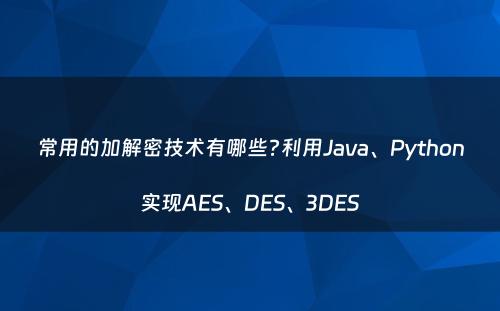网站首页 > java教程 正文
对称加密:使用单个密钥进行加密和解密的技术。常见的对称加密算法包括AES、DES、3DES等
1.下面是使用Java实现AES加密的示例代码:

import javax.crypto.Cipher;
import javax.crypto.spec.SecretKeySpec;
import java.util.Base64;
public class AESEncrypt {
// 加密
public static byte[] encrypt(byte[] content, byte[] keyBytes) throws Exception {
SecretKeySpec key = new SecretKeySpec(keyBytes, "AES");
Cipher cipher = Cipher.getInstance("AES");
cipher.init(Cipher.ENCRYPT_MODE, key);
return cipher.doFinal(content);
}
// 解密
public static byte[] decrypt(byte[] content, byte[] keyBytes) throws Exception {
SecretKeySpec key = new SecretKeySpec(keyBytes, "AES");
Cipher cipher = Cipher.getInstance("AES");
cipher.init(Cipher.DECRYPT_MODE, key);
return cipher.doFinal(content);
}
public static void main(String[] args) throws Exception {
//加密
byte[] key = "1234567890123456".getBytes(); // 密钥需要为16位字节
String content = "Hello, World!"; // 加密内容
byte[] resultEn=AESEncrypt.encrypt(content.getBytes(),key);//加密
String byte2Base64 = Base64.getEncoder().encodeToString(resultEn); // 转为base64格式
System.out.println(byte2Base64); //加密后的base64字符串
//注意跟加密必须使用同一key
//解密
byte[] base642Byte=Base64.getDecoder().decode(byte2Base64); //将base64加密后的结果base64解码
byte[] resultDe=AESEncrypt.decrypt(base642Byte,key); //解密
System.out.println(new String(resultDe));
}
}2.下面是使用Java实现DES加密的示例代码:
import javax.crypto.Cipher;
import javax.crypto.SecretKeyFactory;
import javax.crypto.spec.DESKeySpec;
import java.util.Base64;
public class DESEncrypt {
// 加密
public static byte[] encrypt(byte[] content, byte[] keyBytes) throws Exception {
DESKeySpec key = new DESKeySpec(keyBytes);
SecretKeyFactory keyFactory = SecretKeyFactory.getInstance("DES");
Cipher cipher = Cipher.getInstance("DES");
cipher.init(Cipher.ENCRYPT_MODE, keyFactory.generateSecret(key));
return cipher.doFinal(content);
}
// 解密
public static byte[] decrypt(byte[] content, byte[] keyBytes) throws Exception {
DESKeySpec key = new DESKeySpec(keyBytes);
SecretKeyFactory keyFactory = SecretKeyFactory.getInstance("DES");
Cipher cipher = Cipher.getInstance("DES");
cipher.init(Cipher.DECRYPT_MODE, keyFactory.generateSecret(key));
return cipher.doFinal(content);
}
public static void main(String[] args) throws Exception {
//加密
byte[] key = "1234567890123456".getBytes(); // 密钥需要为16位字节
String content = "Hello, World!"; // 加密内容
byte[] resultEn=DESEncrypt.encrypt(content.getBytes(),key);//加密
String byte2Base64 = Base64.getEncoder().encodeToString(resultEn); // 转为base64格式
System.out.println(byte2Base64); //加密后的base64字符串
//注意跟加密必须使用同一key
//解密
byte[] base642Byte=Base64.getDecoder().decode(byte2Base64); //将base64加密后的结果base64解码
byte[] resultDe=DESEncrypt.decrypt(base642Byte,key); //解密
System.out.println(new String(resultDe));
}
}
3.下面是使用Java实现3DES加密的示例代码:
import javax.crypto.Cipher;
import javax.crypto.SecretKeyFactory;
import javax.crypto.spec.DESedeKeySpec;
import java.util.Base64;
public class TripleDESEncrypt {
// 加密
public static byte[] encrypt(byte[] content, byte[] keyBytes) throws Exception {
DESedeKeySpec key = new DESedeKeySpec(keyBytes);
SecretKeyFactory keyFactory = SecretKeyFactory.getInstance("DESede");
Cipher cipher = Cipher.getInstance("DESede");
cipher.init(Cipher.ENCRYPT_MODE, keyFactory.generateSecret(key));
return cipher.doFinal(content);
}
// 解密
public static byte[] decrypt(byte[] content, byte[] keyBytes) throws Exception {
DESedeKeySpec key = new DESedeKeySpec(keyBytes);
SecretKeyFactory keyFactory = SecretKeyFactory.getInstance("DESede");
Cipher cipher = Cipher.getInstance("DESede");
cipher.init(Cipher.DECRYPT_MODE, keyFactory.generateSecret(key));
return cipher.doFinal(content);
}
public static void main(String[] args) throws Exception {
//加密
byte[] key = "123456789012345678901234".getBytes(); // 密钥需要为24位字节
String content = "Hello, World!"; // 加密内容
byte[] resultEn=TripleDESEncrypt.encrypt(content.getBytes(),key);//加密
String byte2Base64 = Base64.getEncoder().encodeToString(resultEn); // 转为base64格式
System.out.println(byte2Base64); //加密后的base64字符串
//注意跟加密必须使用同一key
//解密
byte[] base642Byte=Base64.getDecoder().decode(byte2Base64); //将base64加密后的结果base64解码
byte[] resultDe=TripleDESEncrypt.decrypt(base642Byte,key); //解密
System.out.println(new String(resultDe));
}
}
使用Python语言实现AES、DES、3DES加密算法:
4.下面是使用Python实现AES加密的示例代码:
import base64
from Crypto.Cipher import AES
def encrypt(key, content):
key_bytes = key.encode() # 密钥需要为16、24或32位字节
cipher = AES.new(key_bytes, AES.MODE_ECB) # 创建AES加密器
content_padded = content + (16 - len(content) % 16) * chr(16 - len(content) % 16) # PKCS#7填充
cipher_text = cipher.encrypt(content_padded.encode()) # 加密
return base64.b64encode(cipher_text).decode() # 转为base64格式并解码为字符串
def decrypt(key, content):
key_bytes = key.encode() # 密钥需要为16、24或32位字节
cipher = AES.new(key_bytes, AES.MODE_ECB) # 创建AES加密器
cipher_text = base64.b64decode(content.encode()) # 解码为字节数组并解码为base64格式
content_padded = cipher.decrypt(cipher_text).decode() # 解密
padding_length = ord(content_padded[-1]) # 获取填充字符的数量
return content_padded[:-padding_length] # 去掉填充字符
下面是使用Python实现DES加密的示例代码:
import base64
from Crypto.Cipher import DES
def encrypt(key, content):
key_bytes = key.encode() # 密钥需要为8位字节
cipher = DES.new(key_bytes, DES.MODE_ECB) # 创建DES加密器
content_padded = content + (8 - len(content) % 8) * chr(8 - len(content) % 8) # PKCS#5填充
cipher_text = cipher.encrypt(content_padded.encode()) # 加密
return base64.b64encode(cipher_text).decode() # 转为base64格式并解码为字符串
def decrypt(key, content):
key_bytes = key.encode() # 密钥需要为8位字节
cipher = DES.new(key_bytes, DES.MODE_ECB) # 创建DES加密器
cipher_text = base64.b64decode(content.encode()) # 解码为字节数组并解码为base64格式
content_padded = cipher.decrypt(cipher_text).decode() # 解密
padding_length = ord(content_padded[-1]) # 获取填充字符的数量
return content_padded[:-padding_length] # 去掉填充字符
下面是使用Python实现3DES加密的示例代码:
import base64
from Crypto.Cipher import DES3
def encrypt(key, content):
key_bytes = key.encode() # 密钥需要为24位字节
cipher = DES3.new(key_bytes, DES3.MODE_ECB) # 创建3DES加密器
content_padded = content + (8 - len(content) % 8) * chr(8 - len(content) % 8) # PKCS#5填充
cipher_text = cipher.encrypt(content_padded.encode()) # 加密
return base64.b64encode(cipher_text).decode() # 转为base64格式并解码为字符串
def decrypt(key, content):
key_bytes = key.encode() # 密钥需要为24位字节
cipher = DES3.new(key_bytes, DES3.MODE_ECB) # 创建3DES加密器
cipher_text = base64.b64decode(content.encode()) # 解码为字节数组并解码为base64格式
content_padded = cipher.decrypt(cipher_text).decode() # 解密
padding_length = ord(content_padded[-1]) # 获取填充字符的数量
return content_padded[:-padding_length] # 去掉填充字符
以上就是关于对称加密,使用单个密钥进行加密和解密的技术,下一篇讲继续讲非对称加密:使用一对密钥进行加密和解密的技术。其中,一个密钥用于加密,另一个密钥用于解密。
猜你喜欢
- 2025-05-24 Synchronized的实现原理详解(看这篇就够了)
- 2025-05-24 Java设计模式:解锁实际开发中的“密码锁”
- 2025-05-24 京东大佬问我,加密后的数据如何进行模糊查询?我的回答满分
- 2025-05-24 产品经理需要了解的接口知识
- 2025-05-24 【密码学】为什么不推荐在对称加密中使用CBC工作模式
- 2025-05-24 在 Spring Boot3 开发中,是不是也为选择合适的加密算法而头疼?
- 2025-05-24 ssl 加密证书
- 2025-05-24 Nacos 中的配置文件如何实现加密传输
- 2025-05-24 加解密的艺术
- 2025-05-24 实现前端传递参数进行加密,Java后端接收数据解密
欢迎 你 发表评论:
- 最近发表
- 标签列表
-
- java反编译工具 (77)
- java反射 (57)
- java接口 (61)
- java随机数 (63)
- java7下载 (59)
- java数据结构 (61)
- java 三目运算符 (65)
- java对象转map (63)
- Java继承 (69)
- java字符串替换 (60)
- 快速排序java (59)
- java并发编程 (58)
- java api文档 (60)
- centos安装java (57)
- java调用webservice接口 (61)
- java深拷贝 (61)
- 工厂模式java (59)
- java代理模式 (59)
- java.lang (57)
- java连接mysql数据库 (67)
- java重载 (68)
- java 循环语句 (66)
- java反序列化 (58)
- java时间函数 (60)
- java是值传递还是引用传递 (62)

本文暂时没有评论,来添加一个吧(●'◡'●)